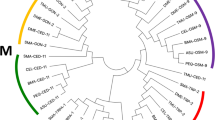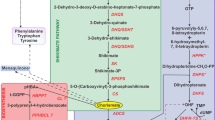Abstract
GLUTAMATE decarboxylase, an enzyme widely found in animals, plants and micro-organisms, has been searched for in intestinal parasites. We have found activity in the four species examined: Ascaridia galli, Ascaris lumbricoides, Taenia solium and Moniezia expansa. Cavier and Savel1 discovered several amino-acid decarboxylases in Ascaris lumbricoides but glutamate decarboxylase was not reported. Campbell2 identified 4-aminobutyrate, product of the reaction, in the free amino-acid fraction of several cestodes, and Monteoliva3 found it in the whole homogenate of Ascaridia galli. The direct relation of 4-aminobutyrate with the tricarboxylic acid cycle—through transamination with 2-oxoglutarate–has been found in brain4, in micro-organisms5 and in plant seeds and tubers6. Impaired respiration mutants of Saccharomyces cerevisiae show increased activity while in normal yeast strains glutamate decarboxylase activity increases as oxygen supply decreases7. As in Ascaris8, succinic acid accumulates in both cases9. The metabolism of intestinal parasites being predominantly anaerobic10, the investigation of a Krebs cycle by-pass system seems worth while.
This is a preview of subscription content, access via your institution
Access options
Subscribe to this journal
Receive 51 print issues and online access
$199.00 per year
only $3.90 per issue
Buy this article
- Purchase on Springer Link
- Instant access to full article PDF
Prices may be subject to local taxes which are calculated during checkout
Similar content being viewed by others
References
Cavier, R., and Savel, J., Bull. Soc. Chim. Biol., 36, 1631 (1954).
Campbell, J. W., Exper. Parasitol., 9, 1 (1960).
Monteoliva, M., Rev. Iber. Parasitol., 22, 255 (1962).
Baxter, C. F., and Roberts, E., J. Biol. Chem., 233, 1135 (1958).
Scott, E. M., and Jakoby, W. B., J. Biol. Chem., 234, 932 (1959).
Gonzalez, P., Cascales, M., Mayor, F., and Santos-Ruiz, A., Nature, 201, 300 (1964).
Olivares, J., Rasero, F. S., Montoya, E., and Mayor, F., Abstracts First Meeting Fed. European Biochem. Soc., p. 75 (London, 1964).
Bueding, E., and Farrow, G., Exp. Parasitol., 5, 345 (1956).
Krebs, H. A., and Lowenstein, J. M., in Metabolic Pathways, edit. by Greenberg, D. M., 1, 173 (Academic Press, N.Y., 1960).
Bueding, E., Physiol. Revs., 29, 195 (1949).
Author information
Authors and Affiliations
Rights and permissions
About this article
Cite this article
MONTEOLIVA, M., RASERO, F., GORGÉ, J. et al. L-Glutamate-l-carboxylase in Intestinal Parasites. Nature 205, 1111–1112 (1965). https://doi.org/10.1038/2051111a0
Issue Date:
DOI: https://doi.org/10.1038/2051111a0
This article is cited by
-
A tribute to Julio López-Gorgé (1935–2004): the music in science
Photosynthesis Research (2005)
Comments
By submitting a comment you agree to abide by our Terms and Community Guidelines. If you find something abusive or that does not comply with our terms or guidelines please flag it as inappropriate.



